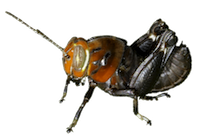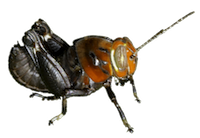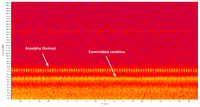Family (Alpha): ACRIDIDAE GRYLLACRIDIDAE GRYLLIDAE GRYLLOTALPIDAE RHAPHIDOPHORIDAE ROMALEIDAE TETRIGIDAE TETTIGONIIDAE TRIDACTYLIDAE
View Gryllidae Members:
Acheta domesticus Anurogryllus arboreus Gryllus unidentified species Gryllus firmus Gryllus fultoni Gryllus pennsylvanicus Gryllus pennsylvanicus/veletis Gryllus pennsylvanicus-veletis Gryllus rubens Gryllus veletis Miogryllus verticalis Velarifictorus micado Hapithus agitator Orocharis unidentified species Orocharis luteolira Orocharis saltator Cycloptilum unidentified species Cycloptilum bidens Cycloptilum pigrum Cycloptilum slossoni Cycloptilum tardum Cycloptilum trigonipalpum Cycloptilum velox Myrmecophilus pergandei Allonemobius allardi Allonemobius fultoni Allonemobius griseus griseus Allonemobius griseus funeralis Allonemobius maculatus Allonemobius socius Allonemobius sparsalsus Allonemobius tinnulus Allonemobius walkeri Allonemobius unidentified species Eunemobius carolinus Eunemobius confusus Eunemobius melodius Eunemobius unidentified species Neonemobius cubensis Neonemobius palustris Neonemobius variegatus Pictonemobius ambitiosus complex Pictonemobius ambitiosus Pictonemobius hubbelli Nemobiinae unidentified species Oecanthus unidentified species Oecanthus celerinictus Oecanthus exclamationis Oecanthus fultoni Oecanthus latipennis Oecanthus nigricornis Oecanthus niveus Oecanthus pini Oecanthus quadripunctatus Neoxabea bipunctata Phyllopalpus pulchellus Anaxipha delicatula Anaxipha exigua Anaxipha litarena Anaxipha rosamacula Anaxipha thomasi Anaxipha tinnula Anaxipha tinnulacita Anaxipha tinnulenta Anaxipha vernalis Anaxipha new species near vernalis Anaxipha unidentified species Cyrtoxipha columbiana Falcicula hebardi Gryllidae unidentified species NC Records
Anaxipha thomasi Walker & Funk, 2014 - Thomas's Trig
Taxonomy
Family: Gryllidae
Subfamily: TrigonidiinaeTribe: TrigonidiiniSynonym: Anaxipha n. sp. D Comments: One of thirteen species in this genus that occur in North America north of Mexico (SINA, 2017); nine have been recorded in North Carolina. Thomasi belongs to the Exigua Species Group, which also includes exigua, tinnula, tinnulacita , and tinnulenta in North Carolina (Walker and Funk, 2014).Species Status: An unusual song variant exists at a site in Chatham County, differing from the typical prolonged, unbroken trills of this species. Specimens need to be collected to determine if this form represents a separate species or even if it belongs in the same genus as thomasi .
Identification
Field Guide Descriptions: Online Photographs: SINA, Google Images ,
iNaturalist , GBIF Technical Description, Adults/Nymphs: Walker and Funk (2014)SINA 630a.htm Comments: A very small, brown Trig. Like other members of the Exigua group, it possess a broad dark stripe on the lateral face of the femur (Walker and Funk, 2014). Structural features -- particularly the number of pegs on the stridulatory file -- must be examined to identify this species; the song is distinctive.Total Length [body plus wings; excludes ovipositor]: 5.5-5.9 mm, males; 6.1-7.1, females (Walker and Funk, 2014)Structural Features: "Stridulatory file with about 150 teeth (range 139-162). Length of ovipositor <2.2 mm" (see Walker and Funk, 2014 for additional structural characteristics). No macropterous individuals have been observed but the sample size is still fairly small.Singing Behavior: The song of Anaxipha thomasi is a trill with a rate of ~21 syllables produced per sec at 77°F (7.8 kHz) (Walker and Funk, 2014), with individual trills typically continuous for long periods of time (see examples on SINA, Macaulay Library, and the Songs of Insects website). However, songs recorded at one site in Chatham County were usually broken into segments with gaps in between, a pattern similar to that of the summer form of Anaxipha vernalis. The pulse rate and dominant frequency are otherwise a good match to that of typical thomasi recorded in other areas, including one site in Iredell County, NC. Among the species of Anaxipha with similarly continuous songs, this rate falls in between A. tinnulacita (13.2 syllables per sec. at 77°F) and A. exigua (43.6 syllables per sec. at 77°F). This rate is also simillar to that of Allonemobius walkeri , but the songs of that species are always produced from the ground rather than from perches up in the vegetation as is always the case with Anaxipha species.Diagnostic Song Parameters: Nymphal Stages and Development: Apparently undescribed but unlikely to be distinguishable, particularly from other members of the Exigua Species Group
Distribution in North Carolina
County Map: Clicking on a county returns the records for the species in that county.
Adult Dates: Click on graph to enlarge
Habitats and Life History
Habitats: This species appears to be particularly tied to pine forests (Walker and Funk, 2014). Our records come from mixed stands of hardwoods and pines, including Loblolly and Shortleaf. One record comes from a disjunct stand of White Pines. Diet: Apparently unrecorded; possibly omnivorousObservation Methods: Singing males are most easily detected but they may also be captured using sweep nettingAbundance/Frequency: We currently have too few records for this species to estimate either its frequency of occurrence or abundanceAdult Phenology: Walker and Funk (2014) report that this species is univoltine, appearing in late summer and persisting into the fall. Our records are all from August to September, consistent with this phenology.
Status in North Carolina
Natural Heritage Program Status: [W3]Natural Heritage Program Ranks: GNR SNR [S2S4]State Protection: Has no legal protection, although permits are required to collect it on state parks and other public landsComments: This recently described species is still too poorly known across its range to estimate either its global or state conservation status. Its occurrence in stands of upland pine forests suggests, however, that it may be fairly secure. However, that remains to be confirmed.
Image Gallery for Anaxipha thomasi - Thomas's Trig Recorded by: Steve Hall Recorded by: Steve Hall, Dee Stuckey, and Savannah Hall Recorded by: Steve Hall Recorded by: Steve Hall Recorded by: Steve Hall Recorded by: Steve Hall Recorded by: Steve Hall Recorded by: Steve Hall Recorded by: Steve Hall

 »
»

 »
»